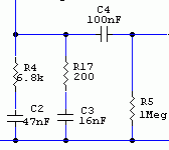Hey guys, Barça 2 - Sttugart 0 half time football match Champions League.😀
OK, see you in Madrid! 😛
Hopefully!
Like Jim Hagerman?
Boa tarde
you guys are to fast for me. Yes Merlin, for example like Jim Hagerman - or others - are doing it.
Have a nice day!!!
Magnifico
Only three words: "simply the best"
Two countries & a heart: Ferrari & Alonso.
Thks a lot.
Only three words: "simply the best"
Two countries & a heart: Ferrari & Alonso.
Thks a lot.
Boa tarde
you guys are to fast for me. Yes Merlin, for example like Jim Hagerman - or others - are doing it.
Have a nice day!!!
Wich others?
Boa tarde
you guys are to fast for me. Yes Merlin, for example like Jim Hagerman - or others - are doing it.
Have a nice day!!!
Olá João
How do you think Jim builds and tests his iRIAA ?
The best way to test a iRIAA is certanly the use of a propperly setup RIAA no ?
Hag's has extra hf cutting head compensation mind you. 50kHz? Here I feed Lipshitz pre emphasis in my sim.
Well considering the Neuman cutting lathe to be the best, maybe we could think about including one more node at 50Khz in the riaa circuit. Maybe we could finally use a higher value 16n and not loose the high freq magical touch because we would be increasing amplification at 50Khz.
Nevertheless i believe this iRIAA is not suitable to finetune our "pure" Lipshitz layout because it is based in a different circuit.
Reading about the iRIAA made me realize it is a passive filter so it is as difficult to determine the correct component values as we have here... so why should we take for granted that it is the ultimate reference ?
Nevertheless i believe this iRIAA is not suitable to finetune our "pure" Lipshitz layout because it is based in a different circuit.
Reading about the iRIAA made me realize it is a passive filter so it is as difficult to determine the correct component values as we have here... so why should we take for granted that it is the ultimate reference ?
I have also made it with an extra resistor in line with the 16n HF riaa cap once. So to comply with extra cutting lathe compensation. I have done so in the Valve itch phono too. I took em out. It did not work to my taste. Thats how it is done if you wanna try in your system and to your taste.
Attachments
I agree with you !
Also, I do not know if every disc is cutted with that 50khz drop off.
Do you know if the coil based riaa circuits have this node in consideration ?
Also, I do not know if every disc is cutted with that 50khz drop off.
Do you know if the coil based riaa circuits have this node in consideration ?
Last edited:
I don't know, there have been articles about it considered a must, others arguing against. I just put it in my phono and in my system, if it does not work for me can be exciting my tweeter's oil can resonance, or something not well frequency compensated in my amp, who knows. Or it can be too much in general. I just talk my narrow experience, can't make or support claims. Beyond scope of personal DIY anyway. You should try it one time to see for your self. About inductive Riaa ready made and screened networks I don't know if they now have it, haven't looked. Those are normally driven by low impedance, I don't think you can just drop em in here.
I was not thinking of droping some coils into the Simplistic..... I am not a wizard like you... And besides that I would not tamper with your work.... What I wanted to know is if someone building a riaa bazed on coils would benefit from using Hagerman iRIAA to finetune 🙂
Just for the fun I made a graph demonstrating the effect the extra resistor makes on the Lipshitz setup.
From 1KHz to 12.500Hz it reduces gain (relative to Lipshitz)... after that it starts to increase gain dramatically.
At 50kHz the Hagerman circuit amplifies more 2.8dB than the Lipshitz.
In the attached image, imagine the 0dB line to be the Lipshitz curve (I straitened it only to better show the effect)
Just for the fun I made a graph demonstrating the effect the extra resistor makes on the Lipshitz setup.
From 1KHz to 12.500Hz it reduces gain (relative to Lipshitz)... after that it starts to increase gain dramatically.
At 50kHz the Hagerman circuit amplifies more 2.8dB than the Lipshitz.
In the attached image, imagine the 0dB line to be the Lipshitz curve (I straitened it only to better show the effect)
Attachments
That is what it is supposed to do, given that there should have been original supersonic energy in the record's groove, lost by the lathe's driving cut off. If you want to experiment for restoring that constant, you need use that resistor.
- Home
- Source & Line
- Analogue Source
- Simplistic NJFET RIAA


 and then
and then  &
& 
